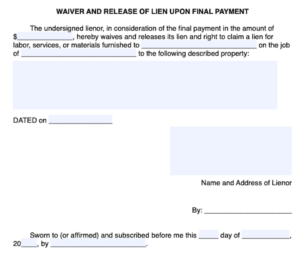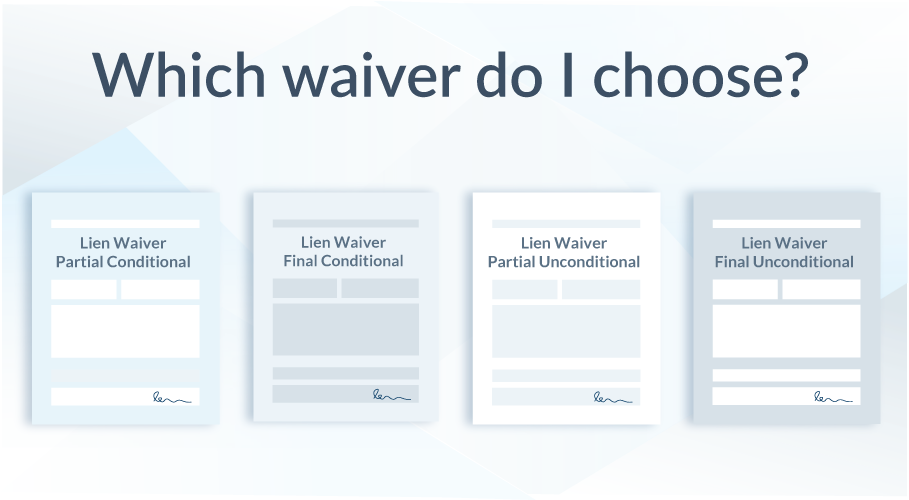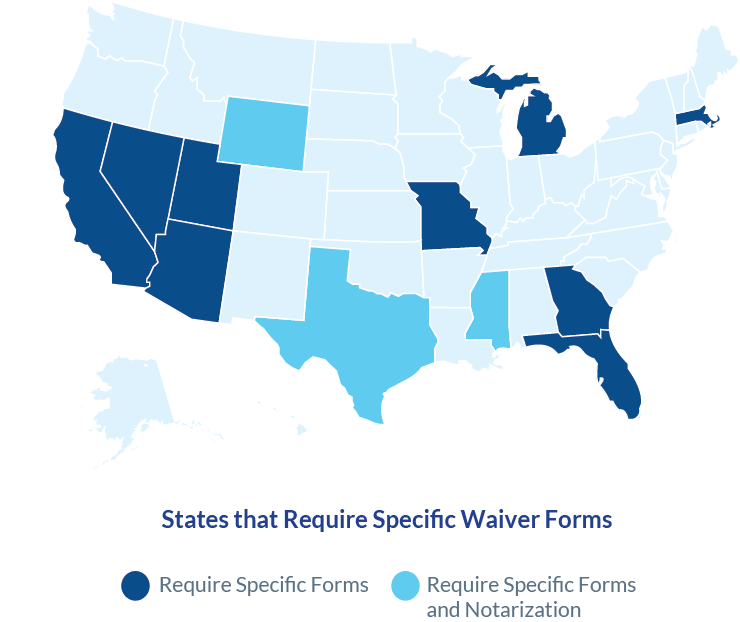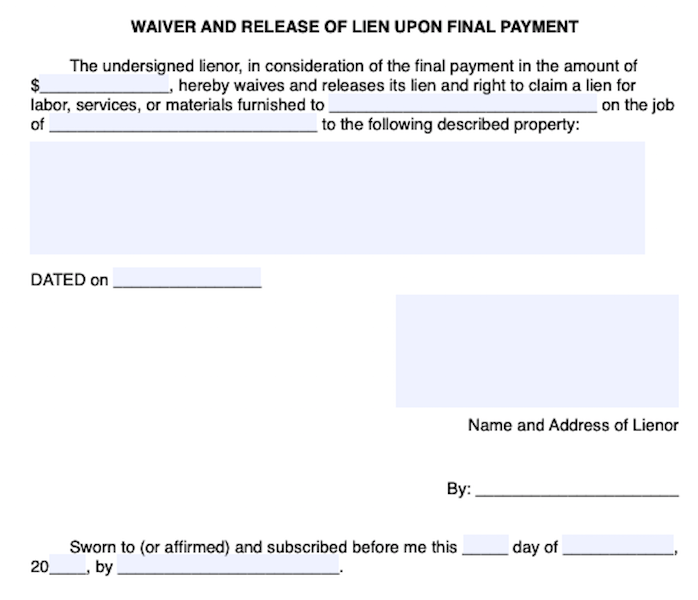

Thousands of lien waiver forms are exchanged every month across the country. Whether you need to exchange a lien waiver for a progress payment or final payment, choosing the right template is important. Some states have statutes that require specific language on the form – using the wrong form could invalidate the waiver. Other states don’t regulate lien waiver forms – as a result, the language on the form could be misleading or dangerous. In all cases, we’ve made finding the right form easy.
A lien waiver may be called a waiver of lien, a lien release, a lien waiver and release, or some combination. Regardless of what the document is called, it’s the language in the document that really matters. Signing a document without understanding what the language means could spell trouble.
Below, find links to download lien waiver and release templates for all 50 states. And below that, we help you understand how to fill out a waiver of lien form, how to read common language in lien waivers, and what to watch out for when working in new states.
Lien Waiver & Release Forms – State by State
Use the following links to download free waiver and release forms for each state.
- Alabama Lien Waiver FAQ & Form
- Alaska Lien Waiver FAQ & Form
- Arizona Lien Waiver FAQ & Form
- Arkansas Lien Waiver FAQ & Form
- California Lien Waiver FAQ &Form
- Colorado Lien Waiver FAQ & Form
- Connecticut Lien Waiver FAQ & Form
- Delaware Lien Waiver FAQ & Form
- Florida Lien Waiver FAQ & Form
- Georgia Lien Waiver FAQ & Form
- Hawaii Lien Waiver FAQ & Form
- Idaho Lien Waiver FAQ & Form
- Illinois Lien Waiver FAQ & Form
- Indiana Lien Waiver FAQ & Form
- Iowa Lien Waiver FAQ & Form
- Kansas Lien Waiver FAQ & Form
- Kentucky Lien Waiver FAQ & Form
- Louisiana Lien Waiver FAQ & Form
- Maine Lien Waiver FAQ & Form
- Maryland Lien Waiver FAQ & Form
- Massachusetts Lien Waiver FAQ & Form
- Michigan Lien Waiver FAQ & Form
- Minnesota Lien Waiver FAQ & Form
- Mississippi Lien Waiver FAQ & Form
- Missouri Lien Waiver FAQ & Form
- Montana Lien Waiver FAQ & Form
- Nevada Lien Waiver FAQ & Form
- Nebraska Lien Waiver FAQ & Form
- N. Hampshire Lien Waiver FAQ & Form
- New Jersey Lien Waiver FAQ & Form
- New Mexico Lien Waiver FAQ & Form
- New York Lien Waiver FAQ & Form
- N. Carolina Lien Waiver FAQ & Form
- N. Dakota Lien Waiver FAQ & Form
- Ohio Lien Waiver FAQ & Form
- Oklahoma Lien Waiver FAQ & Form
- Oregon Lien Waiver FAQ & Form
- Pennsylvania Lien Waiver FAQ & Form
- Rhode Island Lien Waiver FAQ & Form
- South Carolina Lien Waiver FAQ & Form
- South Dakota Lien Waiver FAQ & Form
- Tennessee Lien Waiver FAQ & Form
- Texas Lien Waiver FAQ & Form
- Utah Lien Waiver FAQ & Form
- Vermont Lien Waiver FAQ & Form
- Virginia Lien Waiver FAQ & Form
- Washington Lien Waiver FAQ & Form
- Washington DC Lien Waiver FAQ & Form
- West Virginia Lien Waiver FAQ & Form
- Wisconsin Lien Waiver FAQ & Form
- Wyoming Lien Waiver FAQ & Form

Which Lien Waiver Form Do You Need?
When you go to download your state’s lien release form, you’ll notice that there is more than one of them. There are probably four. And that may get you thinking…which lien waiver form do I actually need?
Generally speaking, most states have 4 different types of lien waivers. It’s important when selecting your template to determine the waiver type and make sure that the type matches the payment situation. The forms labeled “unconditional” are for use after the signing party has been paid, and those labeled “conditional” are for use upon a promise of payment, or in other words, before the signing party has been paid.
- Partial conditional lien waiver is used before receipt of a progress payment
- Final conditional lien waiver is used before receipt of the final payment
- Partial unconditional lien waiver should only be used after receipt of a progress payment
- Final unconditional lien waiver should only be used after receipt of all payments
This is a very simple overview. In deciding which to download, you may want to review our Ultimate Guide to Lien Waivers, where the different types of waivers are more completely discussed. You may find this video helpful to figure out which you should use:

Common Language in Waiver Documents and What It Means
After downloading the waiver form for your state and situation, you will next encounter a bunch of confusing legal language.
In the states where lien waivers are strictly regulated, the terms and language in the waiver document itself can be specifically discussed, because we know exactly what the language is. In the other states, though, lien waiver document language is not as firmly regulated, and as a result, it may be difficult to identify and discuss “common” language.
Nevertheless, although each state’s lien waivers are slightly different, and non-regulated lien waivers can be very different, the language you’ll find in these documents is pretty similar. What’s especially true is that the problematic clauses to look out far are quite similar. It’s just that these similar clauses might be arranged in different ways depending on the individual document at issue.

Language That Sets the Waiver as “Conditional” or “Unconditional”
In many articles and discussions of lien waivers, including this one, you’ll hear the terms “conditional” and “unconditional” used often. However, the truth is that it’s not always clear whether a waiver is one or the other. Check out this question on our Expert Center, for example, where the contractor asks the payment experts for help “to tell the difference between a conditional and non-conditional waiver.“
Since it often matters more what the waivers say rather than what actually happened, it is crucially important for parties to use the correct waiver for the correct situation. Even more to the point: you don’t want to use an unconditional waiver before you’ve been paid!
Common language found in unconditional waivers includes:
- This document waives and releases lien, stop payment notice, and payment bond rights the claimant has for labor and service provided, and equipment and material delivered, to the customer on this job
- Rights based upon labor or service provided, or equipment or material delivered, pursuant to [anything] prior to the date that this document is signed by the claimant, are waived and released by this document
- The Claimant has been paid in full.
All of these phrases signify that the waiver is an unconditional waiver unless the above language is qualified by some limiting language.
Likewise, here is some common language found in conditional waivers:
- This document is effective only on the claimant’s receipt of payment from the financial institution on which the following check is drawn . . .
Common Lien Waiver Language Results In Waiving More Than You Think
Some similar language to that mentioned above can result in parties waiving more than they intended to.
Language on a waiver that the claimant waives “all claims up to [a certain date]” or “all claims on this job” or even “rights based on the furnishing of labor or materials prior to [a certain date] are waived” can create a tricky situation for the claimant.
This type of language (whether limited to an actual, set payment amount or not) specifies that the waiver waives their rights for work performed up until the “through” date listed on the waiver. This means that if the property owner or GC is holding retainage, or if there are pending charge orders or extra work, the waiver can result in the waiving of rights to recover amounts earned but not yet due.
Less Common Language on Waivers That Can Hurt You
There are less common (but not unheard of) clauses and phrases to watch out for, as well. Some waivers contain overly-broad language waiving certain contractual rights, whether claims or defenses.
Language that moves the waiver beyond the realm of mechanics liens or bond claims should be carefully scrutinized prior to signing the waiver document, and waivers containing such language should not be provided to parties to sign, disguised as a simple, run-of-the-mill lien waiver.
Another less-common clause in lien waivers that is still problematic is the inclusion of a personal attestation. The language on the lien waiver requiring the signer to “personally attest” to the contents of the waiver document can create potential personal liability on a construction contract that likely does not have any personal liability otherwise, and should be avoided.
Despite not being universal or standardized forms, the language on lien waivers often means the same thing. Knowing the common things to look for can help understand the lien waiver you are signing or requesting, and to use the appropriate documents in the appropriate situations.
Choosing A Lien Waiver Form When Crossing State Lines
Contractors cross state lines for jobs all the time. It’s just smart business to go where the work is. But one aspect that might be overlooked when crossing state lines is what to do with lien waivers. California waiver rules are different from Arizona’s s, which is different from the rules in Texas, and so on and so forth.
And as a result, crossing state lines without reviewing the documents you’re using can spell trouble.
This section of the post will help you understand and decide which lien waiver templates you should use when you cross state lines to take on a new construction project in another state.
What To Do When Going Into A State with Regulated Waiver Forms
If you’re moving into one of the states that provide statutory forms, then you want to make sure you’re using that state’s specific forms. If you are furnishing materials, labor or services to one of these states, you must use these lien waiver forms or risk your waiver being invalid.
Even within these states, there is a varying degree of how closely the form must be adhered to. Nevada’s Lien Waiver laws, for example, require contractors to use the forms word-for-word. In Florida, on the other hand, standard forms are provided but parties are not required to use them.
When you are doing a job in a state where waivers are regulated or specific suggestions are provided in the laws, the best practice is to use those state-supplied forms.
What To Do When Going Into A State Without Regulated Lien Waivers
The real problem comes when operating in a state without any regulations on lien waivers. Without specific guidelines, this is where we enter the “wild west” of lien waivers. The lack of any specific requirements leads to inconsistency and confusion. In these states, courts have enforced waivers that do a lot more than just waive lien rights.
Parties are given broad discretion to draft lien waivers however they choose. Of course, that doesn’t mean contractors should use this as an opportunity to take advantage of the process.
For states that don’t have required forms, contractors should standardize their waivers – or at least utilize some standardized waiver. By doing so, the contents of a lien waiver will never come as a surprise. Considering the large majority of states don’t have a required form – a contractor could even use the same standardized form in all of those states.
In a state where waiver language and documents are largely unregulated, it may be tempting to slip other language into a lien waiver. It’s unfortunately relatively common for a waiver to waive more than just lien rights. But to have another party unwittingly sign away rights beyond their right to lien is just bad business. It’s sneaky, will lead to disputes, and could even be damning to your reputation in the industry.
At the end of the day, everyone just wants what’s fair and to be paid what they’re owed. We often state that communication and transparency are the keys to solving payment chain issues and greasing the wheels for payment. On top of that, operating fairly will always be good business.
Lien Waiver Software & Document Tools Can Make Forms Easier
Managing waivers can be challenging for your company. Sometimes, it will be as simple as coming to a post like this and downloading the form you need. However, in today’s construction environment, where contractors work with many different contractors (who have different procedures) and in many different places (who have different laws), companies can quickly find themselves in document anarchy. Different docs saved in different places, being used in different circumstances, etc.
Lien waiver software exists to make this easy. Many lien waiver tools and apps will give you easy access to forms without you having to download them one-by-one, and will enable you to quickly and easily use the right form at the right time. Even if you’re getting fillable PDFs — like you’re getting here — it’s still not optimal.
If you’re thinking about how document form-filling tools can help your with your lien waiver processes, or a more complete lien waiver solution may be in your future, consult with our article on the Best Lien Waiver Tools (Reviews & Guide).
Trends With Lien Waivers & Conclusion
Given the widespread use and inherent difficulties with non-statutory forms, there seems to be a trend of states moving towards more regulation and standardization. In the past 5 years, lien waiver regulations and forms were introduced in Mississippi, Texas, and California.
Lien waivers were never intended to be used as other than a receipt of payment and waiver, if you find that you have lost other rights or leverage, the drafter is taking advantage of the state’s lack of regulation. They are designed to prevent abuses, not facilitate them. Believe it or not, more regulation from these “unregulated states” would really simplify performing work across state lines – it would eliminate the confusion, uncertainty, and downright messiness surrounding innumerable different forms.
Until then, though, it’s up to contractors to understand waiver requirements and standardize sound waiver practices. This information should help, and you can always rely on the Levelset items provided here to be the safe, fair, and legally compliant document you need.




